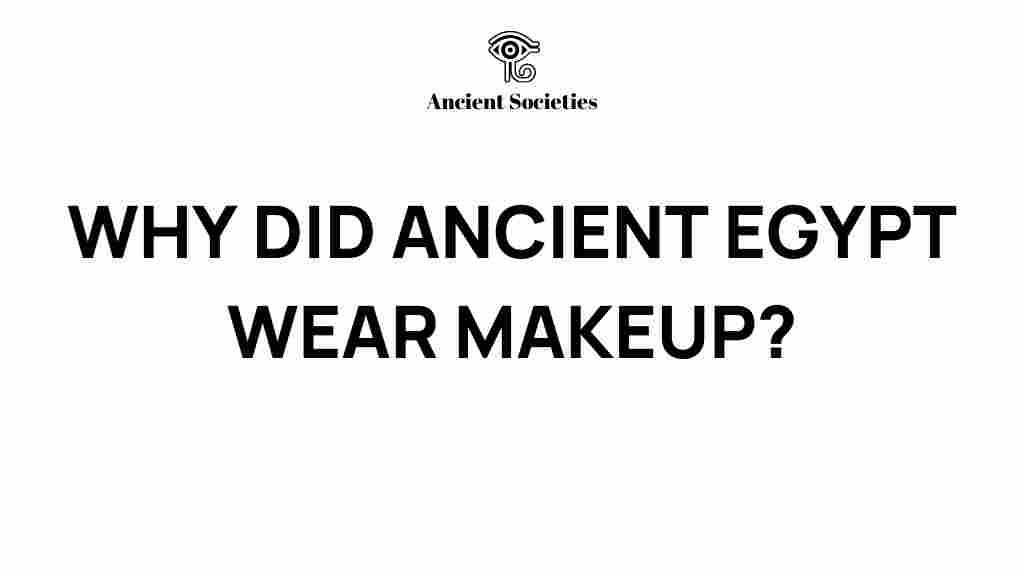The Allure of Ancient Egypt: Unveiling the Secrets of Makeup
Ancient Egypt is often romanticized as a land of pharaohs, pyramids, and profound mysteries. Among the many alluring aspects of this ancient civilization is its rich tradition of makeup and beauty rituals. The Egyptians were not just concerned with aesthetics; their use of cosmetics was deeply intertwined with their culture, health, and societal norms.
This article delves into the history and significance of makeup in Ancient Egypt, exploring how these beauty rituals have influenced modern personal care practices. From the ingredients used in ancient cosmetics to the beliefs surrounding beauty, we unveil the secrets that have captivated generations.
The Cultural Significance of Makeup in Ancient Egypt
Makeup in Ancient Egypt was more than a means of enhancing physical appearance; it was a reflection of one’s social status, health, and spiritual beliefs. The Egyptians believed that beauty was a divine gift, and the use of cosmetics was a way to honor the gods. Here are some key cultural aspects:
- Spiritual Connection: Makeup was often applied during religious ceremonies to honor deities.
- Societal Norms: The application of cosmetics indicated wealth and social status, with elaborate makeup reserved for the elite.
- Health Benefits: Many ingredients used in cosmetics had health properties, such as protecting the skin from the sun and preventing infections.
Key Ingredients in Ancient Egyptian Cosmetics
The Egyptians utilized an array of natural ingredients in their makeup formulations. These ingredients not only served aesthetic purposes but also contributed to skincare and health:
- Kohl: A black powder made from lead sulfide, used to line the eyes. It was believed to ward off evil spirits and protect against the sun’s glare.
- Malachite: A green mineral used to create eye shadow, symbolizing fertility and rebirth.
- Henna: Used for body art and hair dye, henna was also believed to have cooling properties.
- Essential Oils: Oils like myrrh and frankincense were used for moisturizing and fragrance.
Beauty Rituals of Ancient Egyptian Women
Beauty rituals in Ancient Egypt were intricate and varied among different social classes. Women often engaged in daily routines that included:
- Bathing: Regular bathing with scented oils was common, as cleanliness was associated with beauty.
- Makeup Application: Women applied kohl to their eyes and colored powders to their cheeks. Makeup was often blended with oils to enhance application.
- Hair Care: Elaborate hairstyles were adorned with wigs, oils, and accessories.
The Process of Creating Ancient Egyptian Makeup
Creating makeup in Ancient Egypt was an artisanal process. Here’s a step-by-step guide that mimics how they might have crafted their cosmetics:
Step 1: Gather Ingredients
Collect natural minerals and oils, such as kohl, malachite, and myrrh.
Step 2: Grinding and Mixing
Using a mortar and pestle, grind the minerals into a fine powder. For kohl, mix with a small amount of oil to create a paste.
Step 3: Application Tools
Use tools like wooden sticks or fingers to apply the makeup to the desired areas.
Step 4: Storage
Store the cosmetics in small jars made of alabaster or clay to preserve their potency.
Common Troubleshooting Tips
While creating your own ancient-style cosmetics can be exciting, you may encounter some challenges. Here are some troubleshooting tips:
- Consistency Issues: If the mixture is too dry, add a few drops of oil to achieve the desired creaminess.
- Color Intensity: For deeper shades, increase the amount of mineral powder used.
- Application Difficulty: Use different tools, such as brushes or cotton swabs, for easier application.
Skincare Practices in Ancient Egypt
Alongside makeup, skincare was paramount in Ancient Egyptian beauty rituals. The Egyptians understood the importance of maintaining healthy skin. Some of their skincare practices included:
- Moisturizing: Oils such as olive and castor were frequently used to hydrate and protect the skin.
- Sun Protection: Natural oils served as a barrier against harmful UV rays.
- Exfoliation: Using crushed grains and salts to remove dead skin cells was common.
The Legacy of Ancient Egyptian Makeup in Modern Culture
The influence of Ancient Egyptian beauty rituals can still be seen today. Modern makeup companies often draw inspiration from these ancient practices, and the use of natural ingredients is gaining popularity in the beauty industry. Here are some connections:
- Natural Ingredients: The trend towards organic and natural cosmetics echoes the practices of Ancient Egyptians.
- Eye Makeup: The dramatic eye looks inspired by kohl are still popular in contemporary makeup.
- Wigs and Hairpieces: The use of wigs in fashion reflects the ancient practice of adorning hairstyles.
For more insights on the connection between history and modern beauty practices, check out this fascinating article.
Conclusion: The Enduring Allure of Ancient Egyptian Beauty
Makeup and beauty rituals in Ancient Egypt were not merely superficial pursuits; they were an integral part of the society’s culture, health, and spirituality. The allure of Ancient Egypt continues to inspire and educate us about the importance of personal care and the historical context of beauty.
As we embrace modern skincare and makeup practices, understanding the roots of these rituals allows us to appreciate the artistry and significance behind them. Whether you choose to incorporate ancient techniques into your routine or simply admire the history, the legacy of Ancient Egyptian cosmetics endures, inviting us to explore the beauty secrets of the past.
To discover more about the fascinating history of cosmetics and beauty, visit this external resource.
This article is in the category Culture and created by AncientSocieties Team
